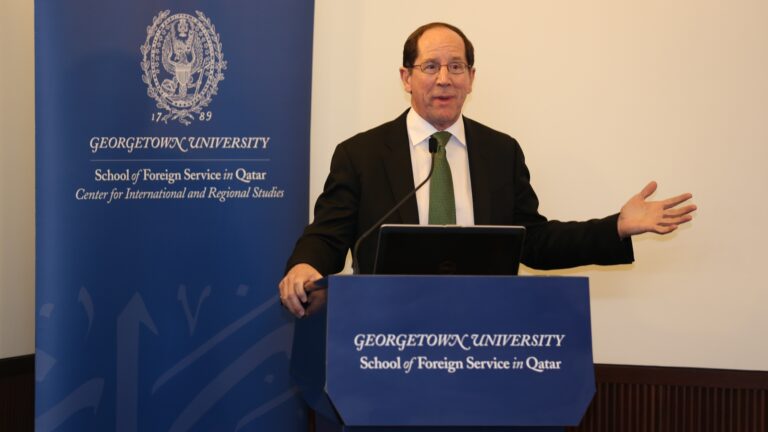American Studies, CIRS Faculty Lectures, Regional Studies
Daniel Lucey on Global Viral Outbreaks

On April 22, 2013, Daniel Lucey, Adjunct Professor of Microbiology and Immunology at Georgetown University Medical Center and an expert on global virus outbreaks, delivered the final CIRS Monthly Dialogue of the 2012-2013 academic year. Titled “Global Travel and Virus Outbreaks 2003-2013,” the talk focused on past global outbreaks of respiratory diseases like SARS and H1N1, and a possible future one that has recently been discovered in the Middle East.
Giving some background into coronavirus epidemics, Lucey explained that the severe acute respiratory syndrome (SARS) coronavirus first appeared in 2002 in Southeast China. He recalled that “by the first half of 2003, the SARS coronavirus had spread to twenty-nine nations on five continents,” largely through air travel. The virus initially spread through hospitals as infected patients transmitted the disease to medical staff who in turn infected family members. The contagion had a 10 percent fatality rate; out of the approximately 8,000 people who were diagnosed, 800 people died. Due to the large percentage of fatalities, the Chinese government received heavy criticism for their handling of the situation, but, according to Lucey, because this was such a novel disease that spread at such a rapid pace, it could not have been predicted, nor easily halted.
The World Health Organization (WHO) coined the term “super spreading event” to describe the rapidity with which the virus was transmitted to multiple people in a short amount of time. A decade after the outbreak of SARS, it is still unclear why one person, known as a “super spreader,” can transmit the virus to more than ten people, while most others who are infected do not transmit it to anyone else. “Of the 238 people with SARS in Singapore, basically, it could all be traced back to five people – five so-called ‘super spreaders,’” Lucey maintained, citing a publication from the WHO.
The SARS coronavirus was initially found to have infected bats, but was then transmitted to intermediate hosts, such as the civet cat, which is known to be a culinary delicacy in some parts of China, Vietnam, and Hong Kong. Through this close contact with animals, the virus infected people, and then became contagious between humans. It is estimated that “two-thirds of all new infectious diseases among humans over the last few decades have originated in animals,” he argued. Once the virus mutated and could be transmitted through the air, it triggered an international outbreak.
In the Middle East, a novel coronavirus appeared in Jordan in 2012 and spread to medical staff at a hospital and some of their family members in much the same pattern as the SARS and H1N1 viruses were transmitted. It was first identified, however, in a patient in Saudi Arabia. The virus was then also reported to have infected patients in Qatar and the UAE. Lucey maintained that “by genetic sequencing, it is very similar to the coronaviruses that are known to exist in bats,” but this connection remains unconfirmed. Lucey posed the question: “is the Middle East coronavirus now, in 2013, like the SARS coronavirus in 2002 in terms of only causing sporadic infections and only rarely causing person-to-person transmission?”
In conclusion, Lucey argued that because “there is no antiviral drug treatment either then or today, neither for the SARS coronavirus, nor the new virus discovered in the Middle East last year,” it is important to be vigilant about preventing the spread of the disease. There are two main lessons that can be learned from the 2002-2003 SARS coronavirus epidemic that can be adapted to mitigate the 2012-2013 new coronavirus in the Middle East. The first is that “hospital outbreaks are early warnings” that indicate the rise of a contagious virus, especially if medical workers infect family members outside of the medical facility. The second is the international spread of a virus due to air travel and contact of an infected person with others in different countries. Lucey argued that “as new virus epidemics occur, they have to start somewhere, and the sooner we can recognize them at the start, the more likely we can stop them, or at least mitigate their serious effects – serious in terms of public health, and serious in terms of economic impact.”
Daniel Lucey, MD, MPH, is a physician who completed his training in infectious diseases and public health at Harvard University hospitals and School of Public Health. He worked at the National Institutes of Health in the US Public Health Service as a Consultant Physician. During the Severe Acute Respiratory (SARS) coronavirus outbreaks in 2003, he traveled to Asia and worked in a “SARS hospital” in Canada to gain first-hand experience with this new viral disease. Similarly, from 2004-2012 he traveled to Asia and Egypt to better understand bird flu viruses.
Article by Suzi Mirgani, Manager and Editor for CIRS Publications.